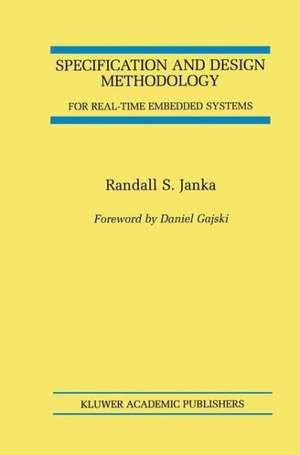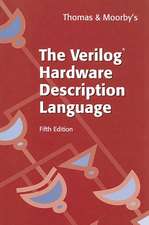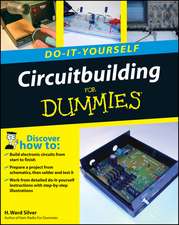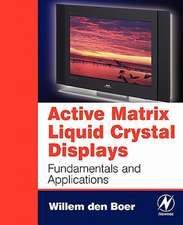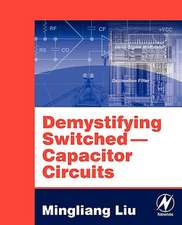Specification and Design Methodology for Real-Time Embedded Systems
Autor Randall S. Jankaen Limba Engleză Paperback – 5 noi 2012
| Toate formatele și edițiile | Preț | Express |
|---|---|---|
| Paperback (1) | 638.43 lei 6-8 săpt. | |
| Springer Us – 5 noi 2012 | 638.43 lei 6-8 săpt. | |
| Hardback (1) | 645.28 lei 6-8 săpt. | |
| Springer Us – 30 noi 2001 | 645.28 lei 6-8 săpt. |
Preț: 638.43 lei
Preț vechi: 751.10 lei
-15% Nou
Puncte Express: 958
Preț estimativ în valută:
122.18€ • 126.83$ • 101.88£
122.18€ • 126.83$ • 101.88£
Carte tipărită la comandă
Livrare economică 25 martie-08 aprilie
Preluare comenzi: 021 569.72.76
Specificații
ISBN-13: 9781461352631
ISBN-10: 1461352630
Pagini: 256
Ilustrații: XXXI, 221 p.
Dimensiuni: 155 x 235 x 13 mm
Greutate: 0.36 kg
Ediția:Softcover reprint of the original 1st ed. 2002
Editura: Springer Us
Colecția Springer
Locul publicării:New York, NY, United States
ISBN-10: 1461352630
Pagini: 256
Ilustrații: XXXI, 221 p.
Dimensiuni: 155 x 235 x 13 mm
Greutate: 0.36 kg
Ediția:Softcover reprint of the original 1st ed. 2002
Editura: Springer Us
Colecția Springer
Locul publicării:New York, NY, United States
Public țintă
ResearchCuprins
1 Introduction.- 1.1 The Basic Problem.- 1.2 A Solution to the Problem.- 1.3 Contributions.- 1.4 Organization.- 1.5 Convergence of Research Threads.- 2 Problem Background.- 2.1 Background.- 2.2 The Domain-Specific Problem.- 2.3 A Domain-Specific Solution.- 3 System Requirements & Intrinsic SDM Assessment.- 3.1 System Requirements Specification Domains.- 3.2 Domain-Relevant Models of Computation.- 3.3 Best MOCs for Domain-Specific Specification Axes.- 3.4 Implicit Framework MOCs.- 3.5 Comparing the Monolithic Frameworks.- 4 Quantified Extrinsic SDM Assessment.- 4.1 A Unified Specification-Modeling Methodology Evaluation Framework.- 4.2 Quantification of Sarkar Basis.- 4.3 Using Quantified Basis to Characterize CASE SDM Frameworks.- 4.4 Conclusion.- 5 Extending Gajski’s SER Methodology.- 5.1 Background.- 5.2 Parallels between Gajski’s SER & Our ADoI.- 5.3 Extending Gajski’s SER to Our ADoI.- 6 The Magic Specification & Design Methodology.- 6.1 Overview of the MAGIC Methodology.- 6.2 Establishing Model Continuity.- 6.3 “Rules”—The Steps of the MAGIC SDM.- 6.4 “Tools”—The Frameworks Integrated into the MAGIC SDM.- 6.5 Model Continuity via Middleware.- 7 Case Study: Validating the Magic SDM Using A Sar Processor Application.- 7.1 RASSP SAR Benchmark Overview.- 7.2 Tabulate Requirements.- 7.3 Capture Non-Constraint Requirements in an Executable Model.- 7.4 Build Executable Workbook with Requirements.- 7.5 Gather Benchmarks for Tokens.- 7.6 Explore Alternative Architectures & Technologies.- 7.7 Make Design Decisions.- 7.8 Create Implementation Specification.- 7.9 Difficulties Encountered & Overcome.- 7.10 Conclusion.- 8 Magic Quantification & Summary.- 8.1 Model continuity in the MAGIC SDM.- 8.2 Sarkar Quantification of MAGIC SDM.- 8.3 Summary.- 9 Conclusion:Directions for Further Research & Applying Magic to Soc Domain.- 9.1 Applied & Basic Research.- 9.2 Applying MAGIC Concepts to the SoC Domain.- 9.3 Virtual Component Codesign (VCC).- 9.4 Codesign vis à vis Coverification.- 9.5 Concluding Comments.- Appendix A: Details of Vsbpl & MPI Middleware.- A. 1 VSIPL: Computation Middleware.- A.2 MPI: Communications Middleware.- Appendix B: Details of Case Study.- B.1 Simulink Details.- B.2 VSIPL Code Generation Subtleties.- B.3 eArchitect Details.- References.
